Analysis of Underwater Melting Process and Leakage Plugging Performance of Phase-Change Materials
Abstract
:1. Introduction
2. Technical Details
2.1. Principles of Plugging Methods
2.2. Self-Priming Plugging Equipment
- (1)
- The induction heating controller converts ordinary AC power (220 V, 50/60 Hz) into DC power, which is then converted into high-frequency high-voltage power with a frequency of 20–40 KHz. The current is input into the underwater heating plate through the wire.
- (2)
- The underwater heating plate is composed of an electromagnetic coil, a waterproof layer, and a shell. The electromagnetic coil is connected to an electromagnetic heat controller. When the high-frequency high-voltage current with high-speed changes enters the coils, the coil produces an alternating magnetic field with high-speed changes. A waterproof sealant is used to encapsulate the electromagnetic coil, and a dense waterproof layer is formed by setting a hard shell on the outside, enabling the device to function normally underwater.
- (3)
- The material encapsulation body consists of a flux conductor, a flexible rim, and a phase-change blocking material. The flexible edge is a frame structure, which forms a cavity to hold the phase-change material. The flux conductor is embedded in the phase-change material. When the magnetic field generated by the underwater heating plate continuously cuts the flux conductor, large amounts of small eddy currents are generated in the flux conductor, which generates heat and melts the phase-change material in the cavity.
2.3. Phase-Change Materials for Plugging Leaks
- (1)
- Density [34]. The phase-change material melting and plugging processes occur underwater, and an excessively low (or high) material density will cause the material to float to the water surface (or sink to the bottom for an excessively high density). This results in material dissipation, reducing the plugging effect. Therefore, the density of phase-change materials used in underwater plugging should be close to that of water.
- (2)
- Melting point and specific heat capacity [35,36,37]. To ensure that the material is rapidly melted into liquid in the underwater environment, the melting point and specific heat capacity of the phase-change material should not be excessively high. Technical requirements stipulate that phase-change plugging materials must be solid at room temperature. Therefore, the melting point of the material should be slightly higher than the room temperature.
- (3)
- (4)
2.4. Leakage Plugging Process
- (1)
- Melting the phase-change sealing material within the adaptable structure of the underwater leakage self-priming plugging equipment.
- (2)
- Deploying the underwater leakage self-priming plugging equipment to envelop the phase-change material around the leakage inlet.
- (3)
- Activating the induction heater to induce heat generation within the sheet iron via high-frequency alternating magnetic fields, thereby heating the phase-change material.
- (4)
- Upon liquefaction of the phase-change material, it is drawn into the leakage channel through the suction of the flow field surrounding the leakage inlet, thus achieving effective leakage plugging.
3. Test Methods
3.1. Test Model
3.2. Observation Process
4. Test Results
4.1. Underwater Melting Characteristics
4.1.1. Underwater Melting Process of Paraffin Waxes
- (1)
- As shown in Figure 5a, before heating, the underwater heating plate of the paraffin wax is laminated to the seepage surface at the seepage inlet. Because the permeability function of the flexible edge guard does not impede the water flow into the seepage hole, the negative suction around the seepage inlet is maintained, enabling the phase-change material to be drawn into the seepage channel.
- (2)
- As shown in Figure 5b, in the first stage, the upper edge of the paraffin surface layer gradually melts, and a small amount of liquid paraffin is sucked into the leakage channel. However, the amount of paraffin flowing into the leakage channel at this stage is very small and cannot provide a sealing effect. This means the iron sheet inside the device melts the surrounding paraffin, transfers heat outward, and melts the solid paraffin surface layer from the middle of the upper edge of the paraffin.
- (3)
- As shown in Figure 5c, in the second stage, the paraffin wax surface melts gradually from the upper edge downward, “spreading”, more paraffin wax flows into the leakage channel, and the material gradually condenses and adheres to the wall of the leakage channel. Consequently, the leakage flow rate is reduced. The surface of paraffin in the device is set parallel to the heating plate, but the paraffin surface melting is highly asynchronous, i.e., it melts gradually from the top to the bottom, which indicates that the internal paraffin surges after melting underwater.
- (4)
- As shown in Figure 5d,e, in the third stage, the melting line of the paraffin wax gradually moves downward, and when it touches the leakage inlet, a large amount of liquid paraffin wax rushes into the leakage channel, resulting in a long-lasting “explosive” inflow phenomenon. The large amount of paraffin solidifies and blocks the leakage channel, rapidly decreasing the leakage flow. This stage is the main leakage plugging stage of the phase-change material.
- (5)
- As shown Figure 5f, in the fourth stage, the melting boundary no longer moves downward. Even after prolonged reheating, the lower part of the surface paraffin within the material encapsulation still fails to melt, and the inner part of the phase-change material cavity is penetrated by water. Leakage out of the water point stops, or only a slight seepage occurs, marking the completion of the sealing. After water penetrates the phase-change material cavity, the heating object is enveloped by water. The above process is the heat transfer mechanism of the heating object to the phase-change material.
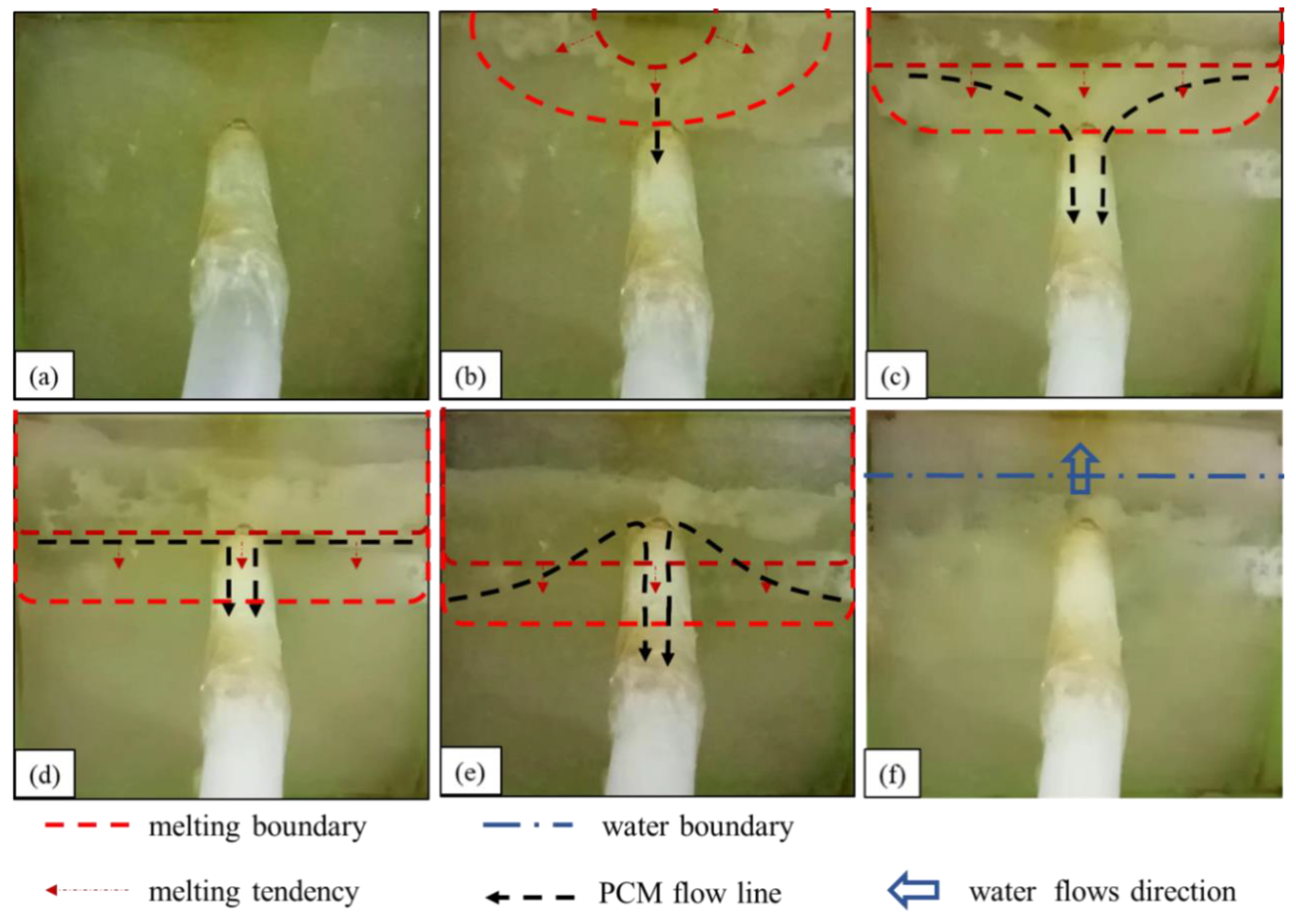
4.1.2. Underwater Melting Process of Rosin
- (1)
- The state before heating is shown in Figure 6a. The water flows into the seepage channel, and the negative pressure suction around the seepage inlet is maintained.
- (2)
- The first stage of the rosin water melting process is shown in Figure 6b. The underwater melting process of rosin is similar to that of paraffin, which also melts gradually at the upper edge. However, unlike the paraffin underwater melting, the ring-shaped melting boundary is absent in the rosin case, and rosin does not flow into the leakage channel.
- (3)
- The second stage of the rosin downward melting process is shown in Figure 6c. The difference between the rosin and paraffin melting is that (1) paraffin gradually spreads through downward melting in a smooth process, whereas rosin melting is rapid; (2) in this stage of melting, rosin does not flow smoothly into the seepage channel but rather adheres to the seepage slope.
- (4)
- The third stage of the rosin underwater melting process is shown in Figure 6d,e. When the rosin melting boundary touches the entrance of the seepage channel, a small amount of the liquid rosin is sucked into the seepage channel, and a larger amount of molten rosin accumulates and solidifies around the entrance of the seepage channel. This process is prolonged, during which the flow rate at the leakage outlet is substantially reduced.This observation suggests that the higher viscosity and faster solidification of rosin make the material solidify in a shorter period of time after it is removed from the heat source. As such, it only solidifies within a small section of the entrance to the seepage channel and impedes the subsequent flow of molten rosin into the seepage channel.
- (5)
- The fourth stage of the rosin underwater melting process is shown in Figure 6f. A larger amount of molten rosin adheres to and is solidified on the surface around the leakage inlet. Water gradually penetrates the interior of the phase-change material cavity, and the heating of rosin fails.

4.1.3. Underwater Melting Process of Stearic Acid
- (1)
- The state of stearic acid before heating is shown in Figure 7a. Water flows into the seepage channel, and the negative pressure suction around the seepage inlet is maintained.
- (2)
- The first stage of the underwater melting of stearic acid is shown in Figure 7b,c. The stearic acid melting starts at the upper edge of the stearic acid, and the melting area gradually expands to both sides and the entire area. This stage of the melting process is similar to that of paraffin but lasts longer.
- (3)
- The second stage of the underwater melting of stearic acid is shown in Figure 7d. The melting boundary extends slowly downward, and some of the molten stearic acid solidifies on the seepage surface with a small amount of stearic acid reaching the surface.
- (4)
- The third stage of the underwater melting of stearic acid is shown in Figure 7e. When the stearic acid melting boundary touches the leakage channel entrance, the stearic acid suddenly rushes into the leakage channel and solidifies rapidly, and the leakage flow rapidly becomes smaller. After the leakage inlet is blocked, the negative pressure suction around the leakage inlet is greatly reduced. The subsequent re-melted stearic acid hardly flows into the leakage channel, and most of it is solidified and bonded to the leakage surface.
- (5)
- The fourth stage of the underwater melting of stearic acid is shown in Figure 7f. Water penetrates the phase-change material cavity, and the heating of the stearic acid fails. After the stearic acid blocks the leakage channel, the leakage is substantially reduced relative to the pre-blocking period, although a slight leakage persists.
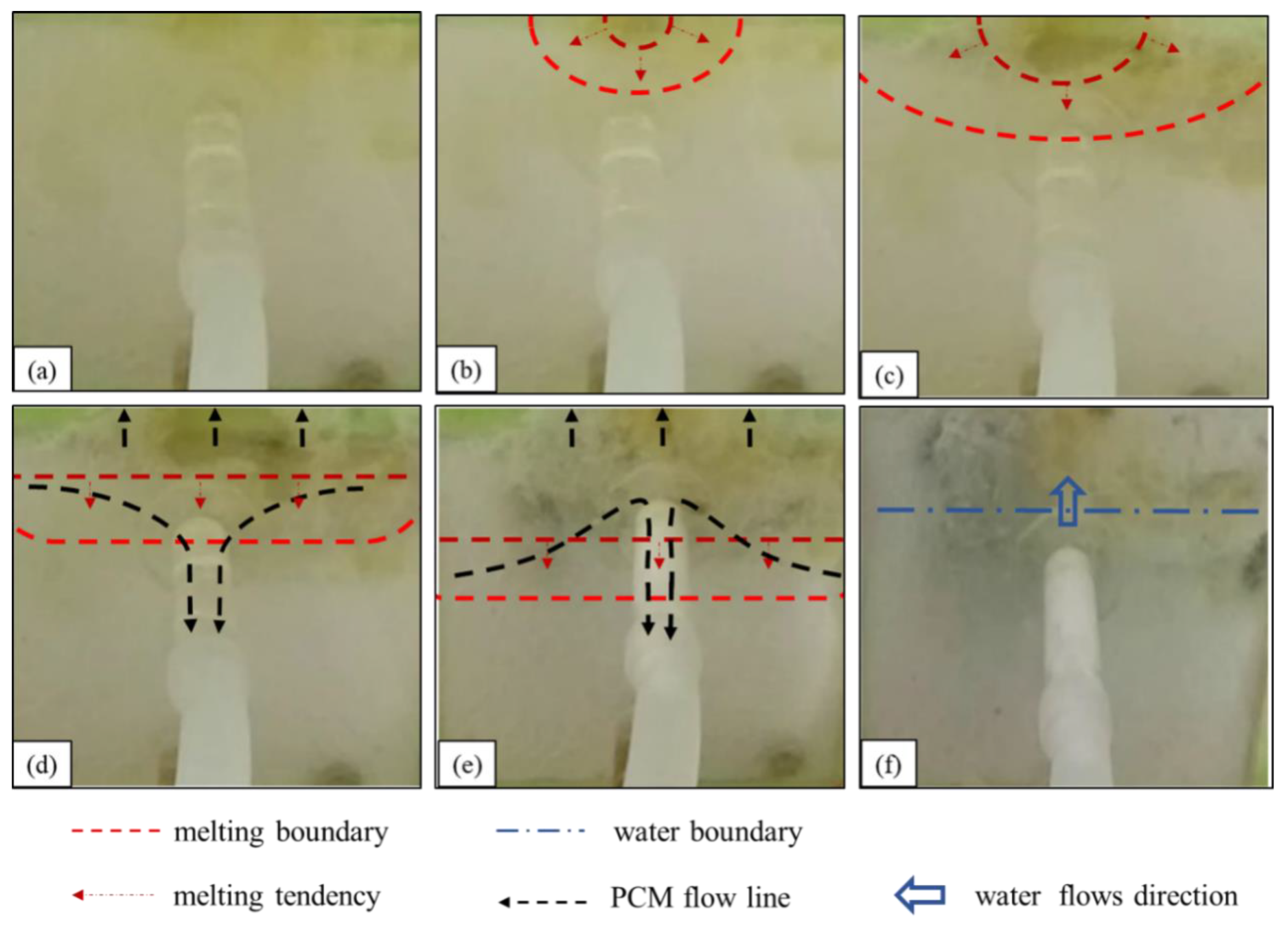
4.2. Leakage Plugging Effect
4.2.1. Effectiveness of Paraffin Plugging
4.2.2. Effectiveness of Rosin Plugging
4.2.3. Effectiveness of Stearic Acid in Plugging Leaks
5. Discussion
5.1. Characterization of Phase-Change Material Melting
5.1.1. Typical Melting Stage Division
- (1)
- During the melting process, the surface of the phase-change material always spreads, melting gradually downward from the upper part;
- (2)
- When water penetrates the material filling cavity of the underwater heating equipment, the heat transfer fails, and the phase-change material within the material encapsulation does not melt even if it is reheated for a longer period;
- (3)
- The longitudinal profile of the residual material is “wedge-shaped”: it is thin at the top and gradually thickens downward.
- (1)
- Initial stage. When the underwater leakage self-priming plugging equipment is activated, the electromagnetic coil inside the underwater heating plate generates a high-speed changing magnetic field, and the iron sheet inside the phase-change material rapidly heats up because of the cutting of magnetic inductance lines. During this phase, the iron sheet rapidly heats up and melts the surrounding material (Figure 11a).
- (2)
- Expansion phase. At this stage, the molten phase-change material conducts heat to the outer solid phase-change material, and the molten material gradually expands in all directions. Both sides of the material spread to the edges of the pore; the bottom of the liquid phase-change material and water contact, the lower part of the formation of the water-filled area, the lower part of the iron sheet, and the phase-change material heat conduction failure; liquid phase-change material upwelling, the upper part of the phase-change material to the surface layer of the melting, part of the phase change material penetration into the flexible edge of the pore, and solidification (Figure 11b).
- (3)
- Wall-breaking stage. The liquid phase-change plugging material accumulates in the upper part of the material encapsulation body, and the phase-change material on the outer edges begins to melt (“breaking through the wall”). After “breaking the wall”, the material flows to the surface because of the suction and buoyancy or flows into the leakage channel. Part of the molten material remains in the material filling cavity (Figure 11c).
- (4)
- Spreading phase. The surface of the phase-change material spreads downward and melts until the melting boundary touches the leakage channel. A large amount of the material is “sucked” into the leakage channel, and the water medium flows rapidly into the material filling cavity. When water fills the space between the iron sheet and the solid phase-change material, the heat transfer between both fails, resulting in material residue in the device (Figure 11d).

5.1.2. Comparison of Underwater Melting Processes
5.2. Plugging Characteristics
6. Conclusions
- (1)
- According to the characteristics of the underwater melting process of paraffin, rosin, and stearic acid, the process can be summarized into the following four typical stages: initial, expansion, wall-breaking, and spreading stages. The underwater melting process of the phase-change materials depends on the melting point, specific heat capacity, and mobility. These factors vary with the plugging window period, which is the main factor affecting the plugging effect.
- (2)
- Combined with the underwater melting process, the plugging effect of the three phase-change materials was analyzed: paraffin had the best plugging effect, but the material strength is low; rosin has a better plugging compactness, but the flow performance is poor, and the material has a low effective plugging rate; stearic acid is easy to dissipate, but the melting point is low.
- (3)
- In a follow-up study, from the melting point, density, mobility, strength, plugging window period, and other aspects of regulating the deployment of phase-change materials, the formation of better performance of the composite phase-change materials in order to improve the effect of self-absorption plugging of underwater leakage.
7. Outlook
- (1)
- While the research test device has made initial strides in addressing challenges related to underwater phase-change material melting and ensuring negative pressure suction around the leakage inlet, there remains a limitation in the quantity of materials that can be carried at once. Further enhancements are necessary to meet the demand for a continuous material supply.
- (2)
- This study delves into the underwater melting process and plugging efficacy of three types of phase-change materials. However, targeted material design tailored to specific plugging requirements is imperative for further refinement.
- (3)
- While this study has yielded promising outcomes within the laboratory setting, its application and efficacy in practical engineering scenarios necessitate ongoing observation and evaluation.
Author Contributions
Funding
Institutional Review Board Statement
Informed Consent Statement
Data Availability Statement
Acknowledgments
Conflicts of Interest
References
- Adamo, N.; Al-Ansari, N.; Sissakian, V.; Laue, J.; Knutsson, S. Dam safety problems related to seepage. J. Earth Sci. Geotech. Eng. 2020, 10, 191–239. [Google Scholar]
- Zhang, X.; Wang, C.-Y.; Wong, H.; Jiang, T.; Dong, J. Modeling dam deformation in the early stage of internal seepage erosion–Application to the Teton Dam, Idaho, before the 1976 incident. J. Hydrol. 2022, 605, 127378. [Google Scholar] [CrossRef]
- Zhong, Q.; Wang, L.; Chen, S.; Chen, Z.; Shan, Y.; Zhang, Q.; Ren, Q.; Mei, S.; Jiang, J.; Hu, L.; et al. Breaches of embankment and landslide dams—State of the art review. Earth-Sci. Rev. 2021, 216, 103597. [Google Scholar] [CrossRef]
- He, K.; Pei, L.; Lu, X.; Chen, J.; Wu, Z. Research and application of critical failure paths identification method for dam risk analysis. Math. Probl. Eng. 2020, 2020, 4103804. [Google Scholar] [CrossRef]
- Jiang, H.; Qiu, X. Performance assessment of a newly developed and highly stable grouting material for a completely weathered granite dam foundation. Constr. Build. Mater. 2021, 299, 123956. [Google Scholar] [CrossRef]
- Lu, H.; Sun, X.; Ma, H. Anti-washout Concrete: An overview. Constr. Build. Mater. 2022, 344, 128151. [Google Scholar] [CrossRef]
- Park, D.; Oh, J. Permeation grouting for remediation of dam cores. Eng. Geol. 2018, 233, 63–75. [Google Scholar] [CrossRef]
- Shen, L.; Luo, S.; Zeng, X.; Wang, H. Review on Anti-seepage Technology Development of Tailings Pond in China. Procedia Eng. 2011, 26, 1803–1809. [Google Scholar] [CrossRef]
- Soralump, S.; Shrestha, A.; Jotisankasa, A.; Thongthamchart, C.; Isaroran, R. Use of geosynthetic clay liner as a remedial measure of claystone degradation in Lam Ta Khong hydropower plant. Geotext. Geomembr. 2021, 49, 1211–1228. [Google Scholar] [CrossRef]
- Qiu, Z. Application of the Dam Underwater Repair Technology in China. In Proceedings of the Symposium on Sustainable Development of Dams and River Basins, New Delhi, India, 24–27 February 2021; p. 27. [Google Scholar]
- Song, J.H.; Ma, L.; Her, Y.; Li, Y. Immediate influences of a large dam construction on local storm event patterns and weather variables: A case study of the Three Gorges Project. Weather 2020, 75, 99–103. [Google Scholar] [CrossRef]
- Lee, B.-S.; You, G.J.-Y. An assessment of long-term overtopping risk and optimal termination time of dam under climate change. J. Environ. Manag. 2013, 121, 57–71. [Google Scholar] [CrossRef] [PubMed]
- Fluixá-Sanmartín, J.; Altarejos-García, L.; Morales-Torres, A.; Escuder-Bueno, I. Climate change impacts on dam safety. Nat. Hazards Earth Syst. Sci. 2018, 18, 2471–2488. [Google Scholar] [CrossRef]
- Lin, X.; Huang, G.; Wang, G.; Yan, D.; Zhou, X. Risk assessment of dam-breach flood under extreme storm events. Front. Environ. Sci. 2021, 9, 742901. [Google Scholar] [CrossRef]
- Zhang, S.; Tang, L.; Jia, Y.; Luo, M. Study on emergency plugging method for underwater leakage passage of dam or dyke. Yangtze River 2019, 50, 169–176. [Google Scholar]
- Sivapriya, S.; Anne Sherin, A. Causes and Consequences of Dam Failures—Case Study. In Sustainable Practices and Innovations in Civil Engineering: Select Proceedings of SPICE 2021; Springer: Berlin/Heidelberg, Germany, 2022; pp. 155–159. [Google Scholar]
- Maijala, T.; Huokuna, M.; Honkakunnas, T. Development of Rescue Actions Based on Dam-Break Flood Analysis; RESCDAM, Final report; Finnish Environment Institute: Helsinki, Finland, 2001. [Google Scholar]
- Zhang, S.; Tang, L.; Jia, Y.; Luo, M. Experimental studies on underwater self-inhaled sealing state of phase change materials. Hydro-Sci. Eng. 2019, 5, 54–61. [Google Scholar]
- Tang, L.; Wang, H.; Xie, Y.; Guan, F.; Jia, Y.; Li, H. Method and Device for Emergency Sealing of Underwater Leakage Crack of Dike by Melting Paraffin Wax. CN107675679B, 14 June 2019. [Google Scholar]
- Zhang, S.; Tang, L.; Jia, Y.; Luo, M. Properties of Composite Phase Transition Material andIts Application in Underwater Emergency Plugging Test. J. Build. Mater. 2020, 23, 1496–1503. [Google Scholar]
- Vakhshouri, A.R. Paraffin as phase change material. In Paraffin Overview; IntechOpen: London, UK, 2020; pp. 1–23. [Google Scholar]
- Monroe, K.A. Advancements in Bio-Based Novel (co) Monomers for Polymeric Materials. Master’s Thesis, Georgia Southern University, Statesboro, GA, USA, 2021. [Google Scholar]
- Patti, A.; Lecocq, H.; Serghei, A.; Acierno, D.; Cassagnau, P. The universal usefulness of stearic acid as surface modifier: Applications to the polymer formulations and composite processing. J. Ind. Eng. Chem. 2021, 96, 1–33. [Google Scholar] [CrossRef]
- Zhao, L.; Ma, W.; Bechta, S. Numerical study on melt underwater spreading with MPS method. Ann. Nucl. Energy 2023, 181, 109581. [Google Scholar] [CrossRef]
- Yokoyama, R.; Kondo, M.; Suzuki, S.; Okamoto, K. Simulating melt spreading into shallow water using moving particle hydrodynamics with turbulence model. Comput. Part. Mech. 2023, 10, 677–690. [Google Scholar] [CrossRef]
- Kundu, P.K.; Cohen, I.M.; Dowling, D.R. Fluid Mechanics; Academic Press: Cambridge, MA, USA, 2015. [Google Scholar]
- Parrondo, J.M.; Horowitz, J.M.; Sagawa, T. Thermodynamics of information. Nat. Phys. 2015, 11, 131–139. [Google Scholar] [CrossRef]
- Tang, L.; Zhang, S.; Jia, Y. Dam Leakage Plugging Robot Based on Negative Pressure Suction and Its Application Method. CN111501675B, 16 April 2021. [Google Scholar]
- Tang, L.; Zhang, S.; Jia, Y. Electromagnetic Heating Device for Underwater Melting Phase Change Material and Preparation Method Thereof. CN109413785A, 1 March 2019. [Google Scholar]
- Xu, Z.; Zhang, J. Phase Transformation in Materials; Higher Education Press: Beijing, China, 2013. [Google Scholar]
- Shamseddine, I.; Pennec, F.; Biwole, P.; Fardoun, F. Supercooling of phase change materials: A review. Renew. Sustain. Energy Rev. 2022, 158, 112172. [Google Scholar] [CrossRef]
- Mehling, H.; Cabeza, L.F. Phase change materials and their basic properties. In Thermal Energy Storage for Sustainable Energy Consumption: Fundamentals, Case Studies and Design; Springer: Berlin/Heidelberg, Germany, 2007; pp. 257–277. [Google Scholar]
- Garg, N.; Khaudiyal, S.; Kumar, S.; Das, S.K. Research trends in phase change materials (PCM) for high-performance sustainable construction. Mater. Today Proc. 2023, 1–7. [Google Scholar] [CrossRef]
- He, B.; Martin, V.; Setterwall, F. Phase transition temperature ranges and storage density of paraffin wax phase change materials. Energy 2004, 29, 1785–1804. [Google Scholar] [CrossRef]
- Kousksou, T.; Jamil, A.; Zeraouli, Y. Enthalpy and apparent specific heat capacity of the binary solution during the melting process: DSC modeling. Thermochim. Acta 2012, 541, 31–41. [Google Scholar] [CrossRef]
- Ferrer, G.; Barreneche, C.; Palacios, A.; Solé, A.; Fernández, A.I.; Cabeza, L.F. Empirical equations for viscosity and specific heat capacity determination of fatty acids. J. Energy Storage 2017, 10, 20–27. [Google Scholar] [CrossRef]
- Yang, X.-H.; Liu, J. A novel method for determining the melting point, fusion latent heat, specific heat capacity and thermal conductivity of phase change materials. Int. J. Heat Mass Transf. 2018, 127, 457–468. [Google Scholar] [CrossRef]
- Delgado, M.; Lázaro, A.; Mazo, J.; Zalba, B. Review on phase change material emulsions and microencapsulated phase change material slurries: Materials, heat transfer studies and applications. Renew. Sustain. Energy Rev. 2012, 16, 253–273. [Google Scholar] [CrossRef]
- Liu, D.; Wang, Y.; Liang, J. Potential applications of phase change materials to extend the winter construction time of earth-rock dam in cold regions. J. Mater. Civ. Eng. 2021, 33, 04021194. [Google Scholar] [CrossRef]
- Lu, X. Research on the application of green energy-saving and environmental protection decoration materials in building decoration construction. Int. J. Environ. Technol. Manag. 2020, 23, 233–244. [Google Scholar] [CrossRef]
- Nazir, H.; Batool, M.; Osorio, F.J.B.; Isaza-Ruiz, M.; Xu, X.; Vignarooban, K.; Phelan, P.; Kannan, A.M. Recent developments in phase change materials for energy storage applications: A review. Int. J. Heat Mass Transf. 2019, 129, 491–523. [Google Scholar] [CrossRef]
- Touze-Foltz, N.; Bannour, H.; Barral, C.; Stoltz, G. A review of the performance of geosynthetics for environmental protection. Geotext. Geomembr. 2016, 44, 656–672. [Google Scholar] [CrossRef]
- Zeng, Y.; Yang, B.; Luo, Z.; Pan, X.; Ning, Z. Fully rosin-based epoxy vitrimers with high mechanical and thermostability properties, thermo-healing and closed-loop recycling. Eur. Polym. J. 2022, 181, 111643. [Google Scholar] [CrossRef]

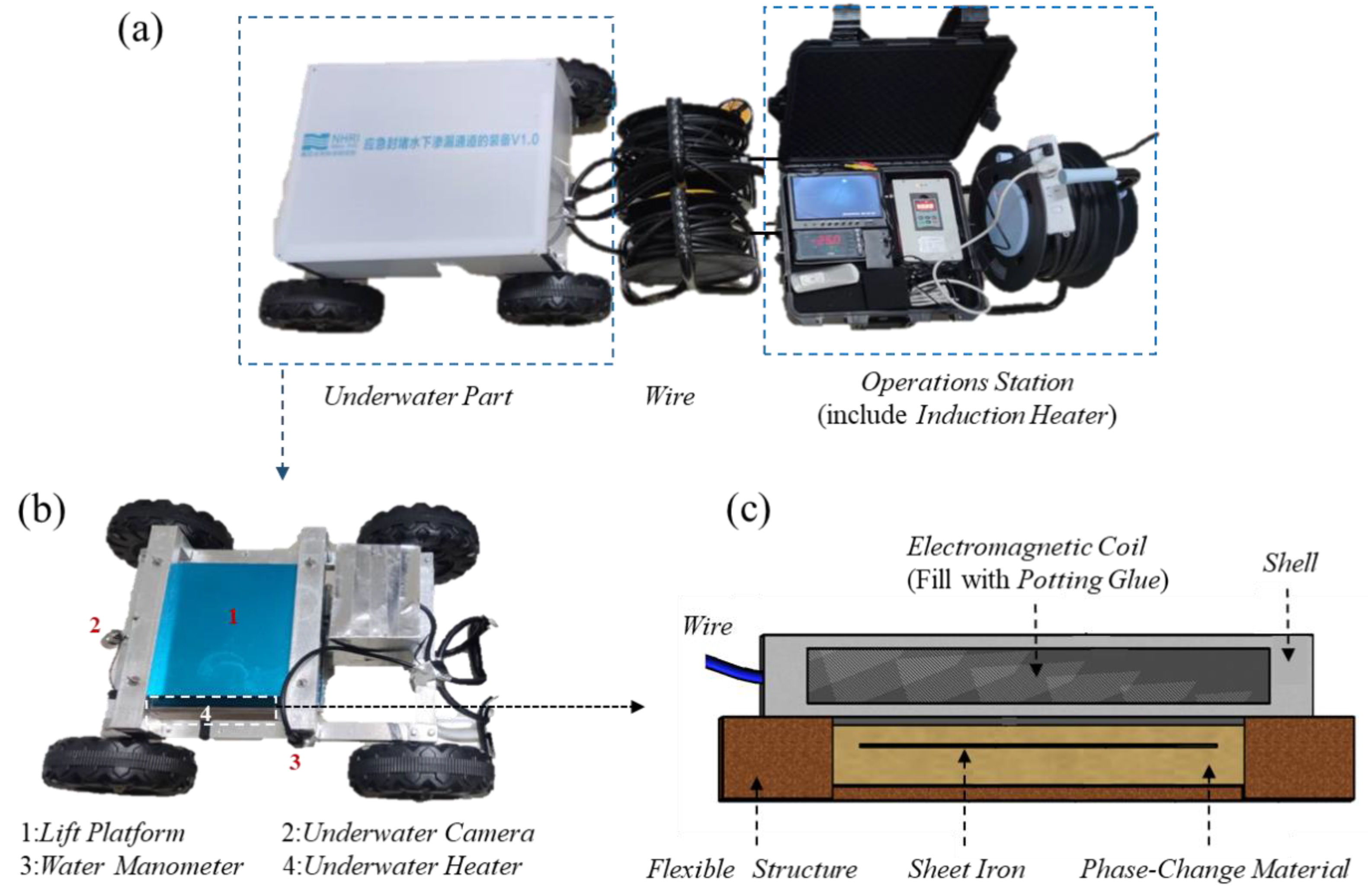
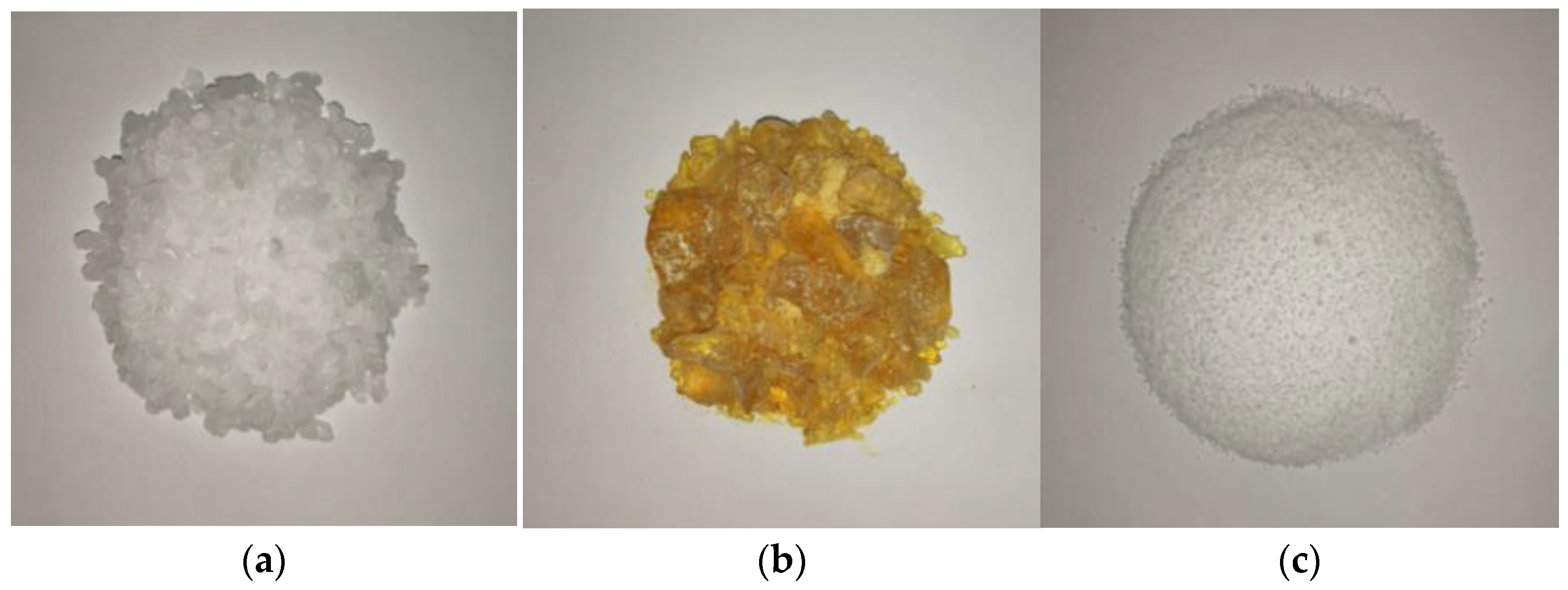


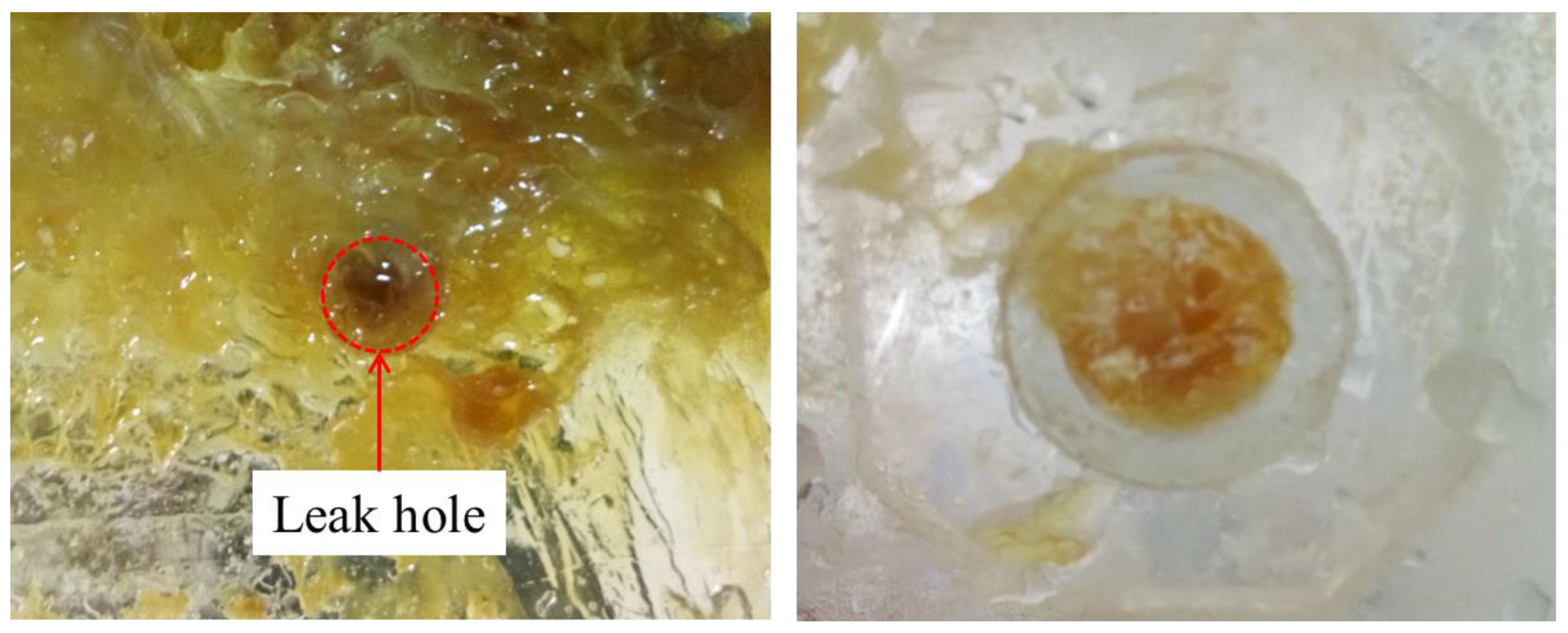
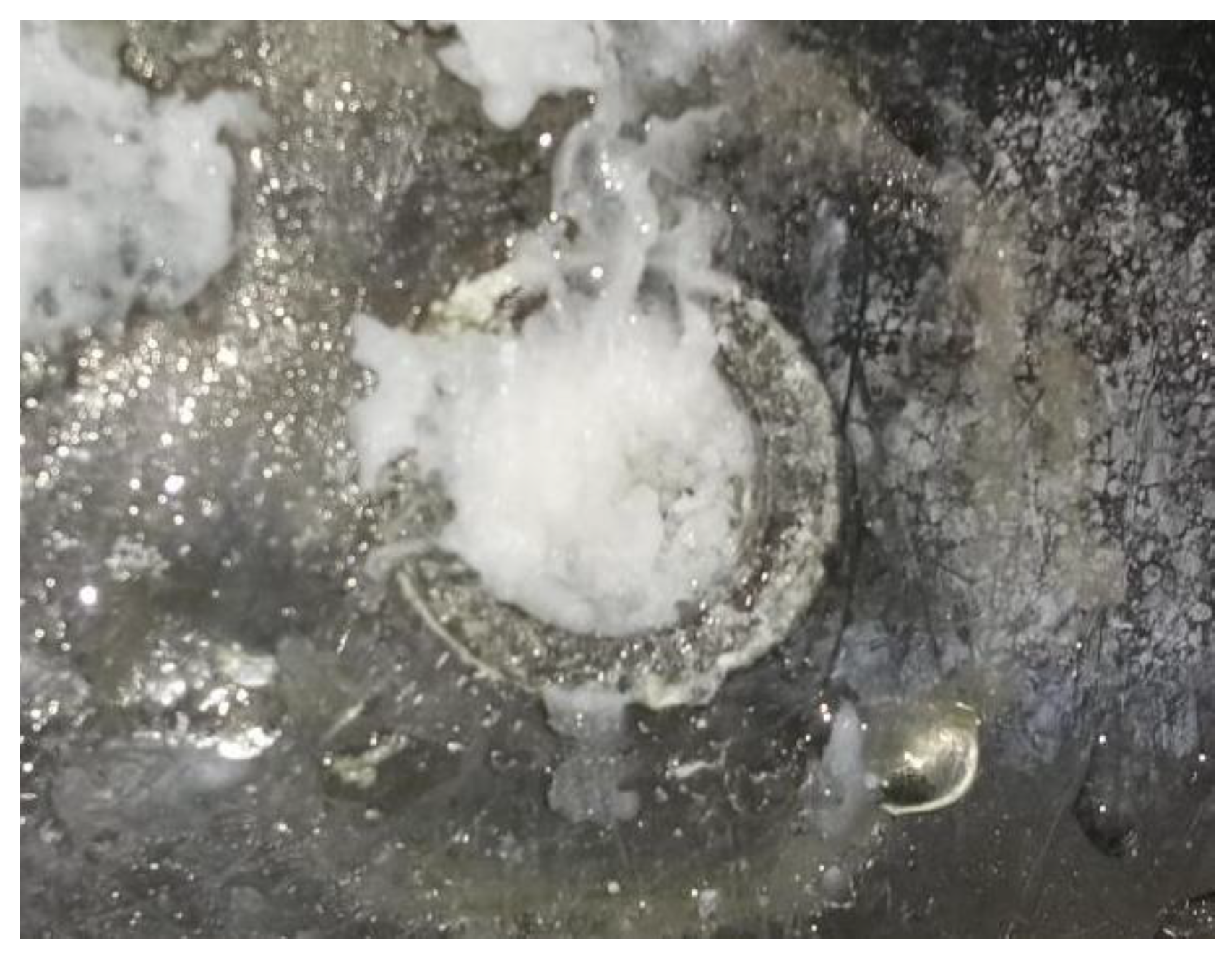
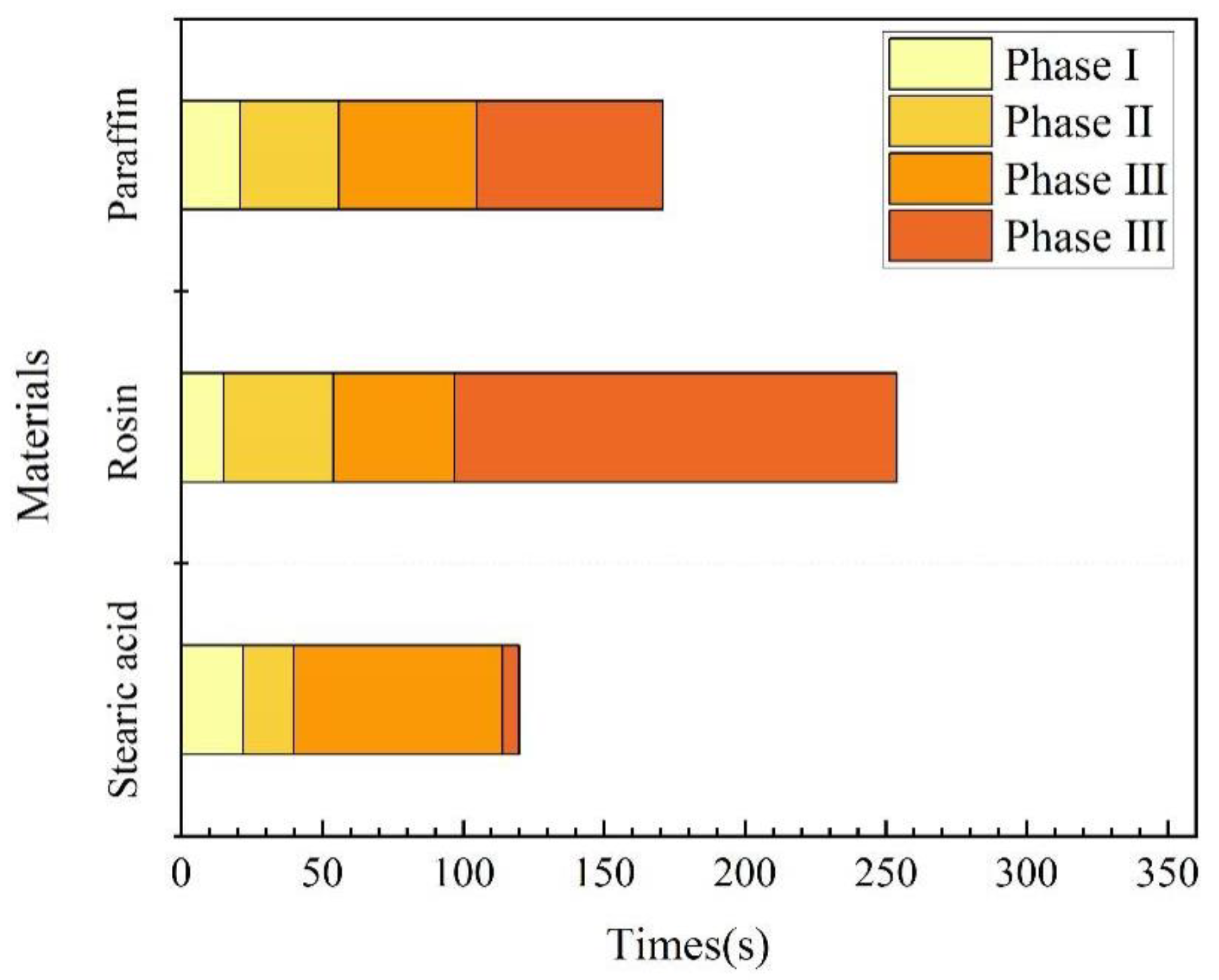
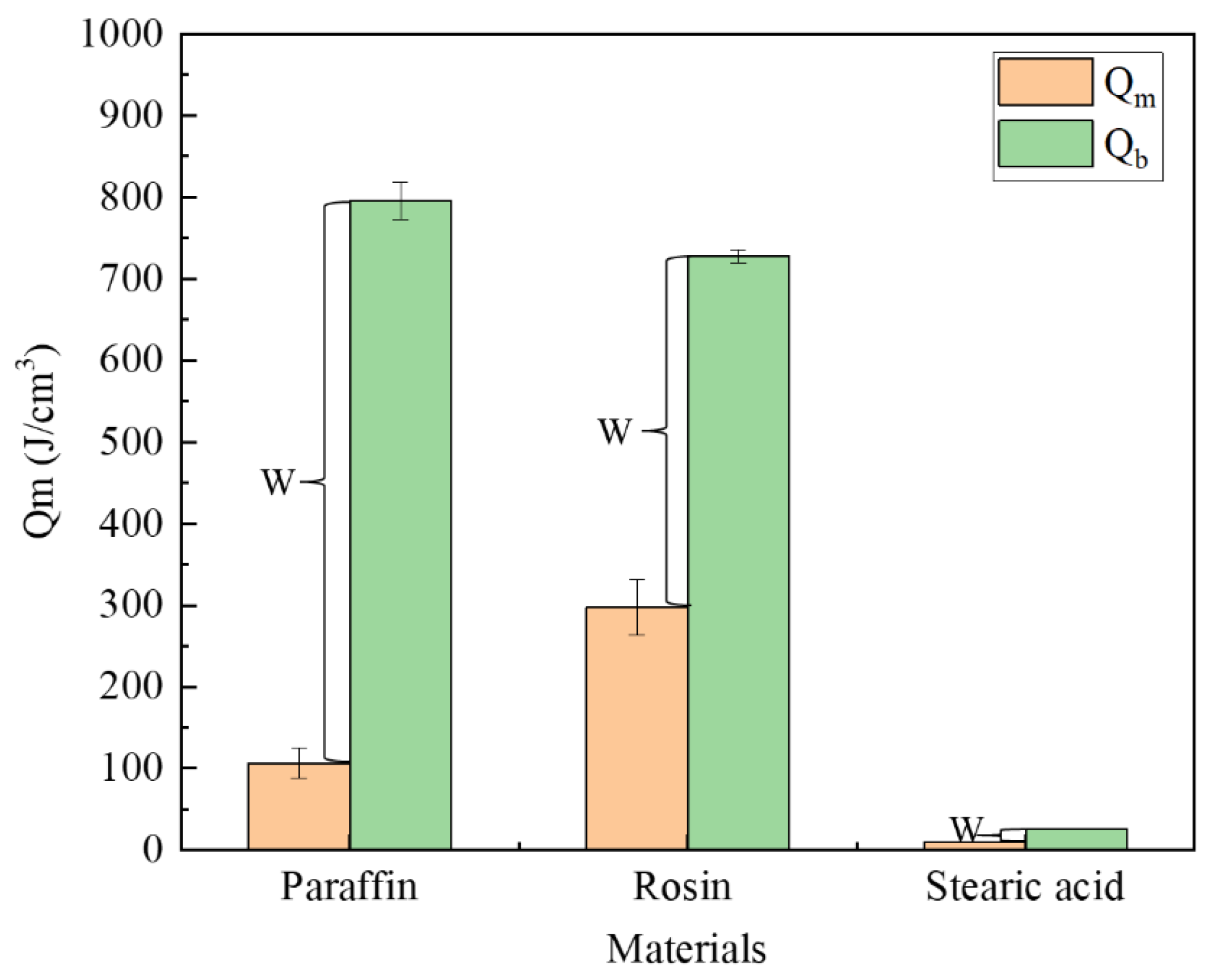
| Phase-Change Material | Density/g·cm−3 | Fusion Point/°C | Boiling Point/°C | Specific Heat/J·kg−1·K−1 |
|---|---|---|---|---|
| Paraffin | 0.88–0.915 | 47–64 | 412–420 | 2130 |
| Rosin | 1.060–1.085 | 110–135 | 300 | 2260.8 |
| Stearic acid | 0.9408 | 67–69 | 183–184 | 149.7 |
| Material | Paraffin | Rosin | Stearic |
|---|---|---|---|
| Advantage | Long blocking length, suitable melting point, stable, easy to control, good fluidity, and suitable viscosity. | Harder, better plugging compactness. | Small volume shrinkage after liquid–solid transformation, suitable melting point, and excellent fluidity. |
| Disadvantage | Lower strength, volume contraction of the material after solidification, and uneven distribution of material along the blockage length. | Poor mobility, easy to change state through heating; brittle, easy to age. | Small specific heat capacity, fast solidification, short plugging length, and difficult to control. |
Disclaimer/Publisher’s Note: The statements, opinions and data contained in all publications are solely those of the individual author(s) and contributor(s) and not of MDPI and/or the editor(s). MDPI and/or the editor(s) disclaim responsibility for any injury to people or property resulting from any ideas, methods, instructions or products referred to in the content. |
© 2024 by the authors. Licensee MDPI, Basel, Switzerland. This article is an open access article distributed under the terms and conditions of the Creative Commons Attribution (CC BY) license (https://creativecommons.org/licenses/by/4.0/).
Share and Cite
Zhang, S.; Tang, L.; Li, F.; Li, P.; Sima, Y.; Zhao, S. Analysis of Underwater Melting Process and Leakage Plugging Performance of Phase-Change Materials. Materials 2024, 17, 2647. https://doi.org/10.3390/ma17112647
Zhang S, Tang L, Li F, Li P, Sima Y, Zhao S. Analysis of Underwater Melting Process and Leakage Plugging Performance of Phase-Change Materials. Materials. 2024; 17(11):2647. https://doi.org/10.3390/ma17112647
Chicago/Turabian StyleZhang, Shenghang, Lei Tang, Fei Li, Po Li, Yao Sima, and Song Zhao. 2024. "Analysis of Underwater Melting Process and Leakage Plugging Performance of Phase-Change Materials" Materials 17, no. 11: 2647. https://doi.org/10.3390/ma17112647
APA StyleZhang, S., Tang, L., Li, F., Li, P., Sima, Y., & Zhao, S. (2024). Analysis of Underwater Melting Process and Leakage Plugging Performance of Phase-Change Materials. Materials, 17(11), 2647. https://doi.org/10.3390/ma17112647






